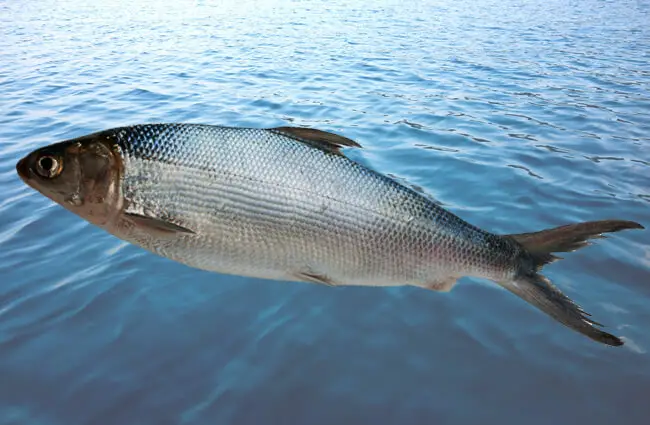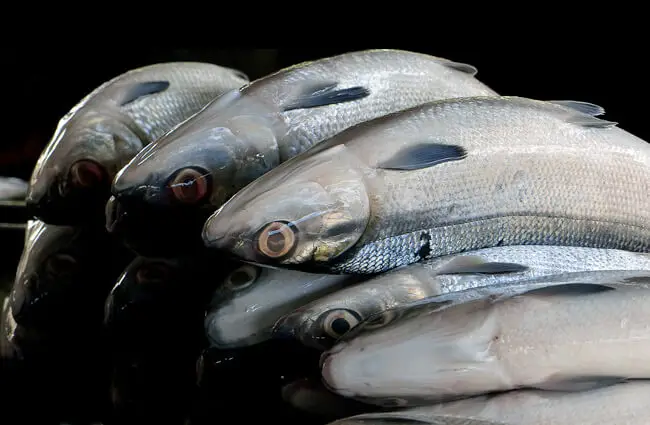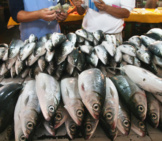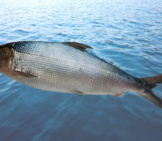The Milk Fish, also known as the milkfish, is a species of fish in the Chanidae family. It lives throughout much of the Indian and Pacific Oceans. This fish is an incredibly important source of food throughout this region. In fact, many consider this species the national fish of the Philippines. Read on to learn about the Milk Fish.
Description of the Milk Fish
This species looks like a typical silvery-colored fish. It has an elongated, torpedo-shaped body. The dorsal, or upper side of its body is darker than the ventral, or underside. Its tail fin is relatively long compared to the rest of its body.
On average, these fish measure about three feet long. However, the largest individuals reach nearly six feet in length.
Interesting Facts About the Milk Fish
At a glance, this fish appears somewhat unremarkable. Learn more about what makes this species so interesting, below.
- A Fish of Many Names – People catch and eat this species in many different regions. Consequently, people in these different regions call this fish by many different names, including ava, bangus, ibiya, bolu, and more.
- Fish Farming – To help keep up with the demand for this fish, people have developed commercial fish farms in the Philippines, Taiwan, Indonesia, and more. Depending on the facility, they keep and breed the fish in concrete tanks, sea cages, or large ponds.
- Multiple Methods – After catching the fish, people have multiple methods of processing it for consumption. Some smoke, ferment, or dry the meat. Others eat it fresh or freeze it, and some even can and bottle the meat.
- Bandeng Presto – The Javan people prepare this fish into a dish known as bandeng presto. The dish involves pressure cooking the fish for long periods until the bones of the fish become soft and edible.
Habitat of the Milk Fish
This fish lives in different habitats depending on its age. The young are born in the ocean, but make their way into estuaries, mangroves, bays, and lakes to continue their growth. As adults they live in tropical coastal seas. They prefer shallow waters near reefs to forage for food.
Distribution of the Milk Fish
You can find this species in coastal regions throughout the Indian and Pacific Oceans. They range from the coast of South Africa, up along the southern coast of Asia, and throughout the Indo-Pacific islands to Australia. Their range also extends to Hawaii, California, and the west coast of Mexico, Central America, and South America.
Diet of the Milk Fish
This fish is an omnivore, which means that they eat both plants and other animals. Their exact diet varies based on the age of the fish.
Newly hatched larvae eat zooplankton, while juveniles hunt for bacteria, algae, worms, tiny shrimp, and carrion. Adults eat all of the above, but they also prey on the larval forms of other sea creatures, including juvenile herrings, sardines, and more.
Milk Fish and Human Interaction
Humans rely on this fish species quite heavily as a source of food. Commercial fisheries bring in several hundred thousand tons per year.
Though heavy fishing poses some threat, the more pressing concern is the collection of larval young to supply fish farms. However, for now the species has strong population numbers and the IUCN lists them as Least Concern.
Domestication
Though people raise this fish in fish farming operations, humans have not truly domesticated this species.
Does the Milk Fish Make a Good Pet
No, this fish does not make a good pet. They grow too large for the average home aquarium.
Milk Fish Care
Care varies based on the fishery setting. Fish farmers keep these creatures in a variety of different housing, including sea pens, concrete tanks, and large ponds.
Some fisheries breed and raise the fish. However, other fisheries capture the larval young from the wild and raise them in the tanks until they have reached harvesting age.
Behavior of the Milk Fish
Researchers simply have not studied this species enough to understand its behavior fully. What we do know, is that they live in social groups known as schools.
Adults spend much of their time near the coasts in tropical seas. They forage for food in reefs and lagoons. Though the young eventually make their way into estuaries and mangroves, the adults breed in shallow waters near the coast.
Reproduction of the Milk Fish
These fish reproduce via spawning, where fertilization occurs outside of the body. Females release their eggs into the water column, and the males release their sperm to fertilize them. A single female can produce up to six million eggs in a spawning season.
It takes about a day for the eggs to hatch, and about a week for the young to make their way into the estuaries and mangroves. The young fish do not reach sexual maturity until they reach about three years of age.











![Red Angus Closeup of a beautiful Red Angus cowPhoto by: U.S. Department of Agriculture [pubic domain]https://creativecommons.org/licenses/by/2.0/](https://animals.net/wp-content/uploads/2020/03/Red-Angus-4-238x178.jpg)












![Red Angus Closeup of a beautiful Red Angus cowPhoto by: U.S. Department of Agriculture [pubic domain]https://creativecommons.org/licenses/by/2.0/](https://animals.net/wp-content/uploads/2020/03/Red-Angus-4-100x75.jpg)

